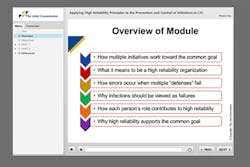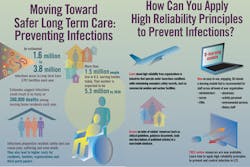Infection Prevention and Control in Long-Term Care Settings
By Maria Perno Goldie, RDH, MS
The Joint Commission seeks to continuously improve health care for the public, in collaboration with other stakeholders, by evaluating health care organizations and inspiring them to excel in providing safe and effective care of the highest quality and value.1 It was founded in 1951, and it accredits and certifies more than 20,500 health-care organizations and programs in the United States, including hospitals and health care organizations that provide ambulatory and office-based surgery, behavioral health, home health care, laboratory, and nursing home services.1
It is an independent and not-for-profit organization, and has two nonprofit affiliate organizations. One is The Joint Commission Center for Transforming Healthcare, whose goal is to solve health care’s most critical safety and quality problems.2 Their mission is: “To transform health care into a high-reliability industry by developing highly effective, durable solutions to health care’s most critical safety and quality problems in collaboration with health care organizations, by disseminating the solutions widely, and by facilitating their adoption.”2
The other affiliate is Joint Commission Resources (JCR), which offers consulting services, educational services, and publications.3 Joint Commission International, a division of JCR, accredits and certifies international health care organizations.4
A new Joint Commission online learning module presents information on how to apply high reliability principles to reduce infections in long-term care settings such as nursing homes and assisted living facilities. The educational program, “Applying High Reliability Principles to the Prevention and Control of Infections in Long Term Care,” was partially funded through a conference grant from the Agency for Healthcare Research and Quality (AHRQ).5 The module takes 50 minutes to complete, is user-friendly, and can be watched in one sitting or in two parts. There is no cost involved, and can be accessed online or in a CD format.
Infections in long term care facilities are a serious business, and the facts regarding them are astonishing.6
- An estimated 1.6 million to 3.8 million infections happen in long-term care facilities every year.
- In excess of 1.5 million people live in 16,000 nursing homes in the United States.
- Estimates propose that infections could cause as many as 380,000 deaths among residents each year.
- The nursing home population is estimated to increase to about 5.3 million people by 2030.6
By viewing this course, the user should then be able to recognize how infection prevention and control practices in long-term care can incorporate high reliability principles. A systems approach to preventing errors related to infection prevention and control is presented, and can be generalized to the learner’s own facility or institution. There is an Index of Resources Related to Long Term Care High Reliability Infection Prevention and Control which covers topics such as clinical practice guidelines, cleaning and disinfection, clostridium difficile, immunization, and other topics.7
As the population ages, we will have more patients, friends, and loved ones in long-term care facilities. According to the Congressional Budget Office, by 2050, one-fifth of the total U.S. population will be 65 or older, up from 12% in 2000 and 8% in 1950.8 The number of people age 85 or older will grow the fastest over the next few decades, constituting 4% of the population by 2050, or 10 times its share in 1950.
Older adults are vulnerable to acquire an infectious disease, be hospitalized for it, suffer complications, and die. Despite the incredible value vaccines hold in preventing these diseases, barriers in infrastructure, cost, education, tracking, and research cause vaccination rates in seniors to fall short of targets set by the Centers for Disease Control and Prevention.9 Let’s do our part to promote wellness, encourage vaccinations, and reduce illness in these facilities.
References
- http://www.jointcommission.org/.
- http://www.centerfortransforminghealthcare.org/.
- http://www.jcrinc.com/.
- http://www.jointcommissioninternational.org/.
- http://www.jointcommission.org/HRipcLTC.aspx.
- Joint Commission Press Release, OAKBROOK TERRACE, Ill. – July 22, 2014. http://www.pwrnewmedia.com/2014/joint_commission/long_term_care_education/downloads/printfriendly.pdf.
- https://manual.jointcommission.org/Literature/WebHome.
- Congressional Budget Office. http://www.cbo.gov/publication/44363.
- The Silver Book: Infectious Diseases and Prevention through Vaccination. http://www.silverbook.org/uploads/images/Silver%20Book_Prevention%20through%20Vaccination_Fact%20Sheet.pdf.


